西方文化导论 考试复习
- 格式:docx
- 大小:21.74 KB
- 文档页数:7

西方文论复习提纲
集团文件版本号:(M928-T898-M248-WU2669-I2896-DQ586-M1988)
名词解释
1、模仿说
2、寓教于乐 6、诗意栖居 7、戏剧情景理论
8、有人气的英雄 9、艺术风格、民族文学、世界文学 10、理想的诗
12、酒神精神 12、日神精神
13、语言即艺术 15、陌生化理论 16、诗意栖居 17、作品召唤论
19、复调小说 19、对话理论 20、期待视野
简答
1、柏拉图创作动力过程。
4、文学的崇高风格
7、狄德罗戏剧冲突的新见解是什么?
8、莱辛如何看待诗与画的区别?
10、什么是理想的诗?
12、尼采日神精神与酒神精神
12、尼采对审美苏格拉底主义的批判
12、尼采认为悲剧是如何诞生的?
13、克罗齐的艺术独立观
13、克罗齐的艺术本质观
15、什克洛夫斯基如何看待文艺自主性?
16、海德格尔诗以语词确立存在。
16、海德格尔的诗是对神性的尺度采纳
17、萨特的作品召唤论是什么?
17、萨特的阅读创造论是什么?
19、复调小说及特点?
19、巴赫金对话理论是什么?
论述
1、柏拉图的文艺创作论
2、试述亚里士多德悲剧理论
3、贺拉斯的古典主义原则
16、海德格尔认为诗是对神性尺度的采纳,对此你怎么看?
16、海德格尔认为艺术的本质是什么?作品的存在有何特征?
19、狂欢化诗学观
17、20、何为作品召唤论和阅读创造论,这与文学的期待视野有何关系?
20、为什么说文学史就是一部文学接受史?。
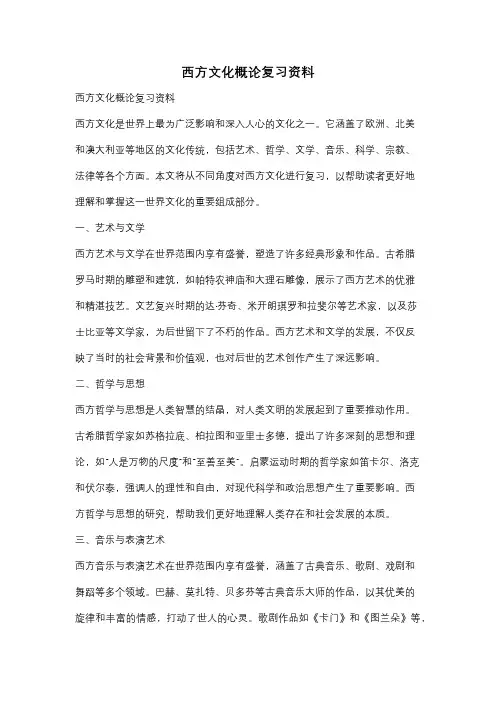
西方文化概论复习资料西方文化概论复习资料西方文化是世界上最为广泛影响和深入人心的文化之一。
它涵盖了欧洲、北美和澳大利亚等地区的文化传统,包括艺术、哲学、文学、音乐、科学、宗教、法律等各个方面。
本文将从不同角度对西方文化进行复习,以帮助读者更好地理解和掌握这一世界文化的重要组成部分。
一、艺术与文学西方艺术与文学在世界范围内享有盛誉,塑造了许多经典形象和作品。
古希腊罗马时期的雕塑和建筑,如帕特农神庙和大理石雕像,展示了西方艺术的优雅和精湛技艺。
文艺复兴时期的达·芬奇、米开朗琪罗和拉斐尔等艺术家,以及莎士比亚等文学家,为后世留下了不朽的作品。
西方艺术和文学的发展,不仅反映了当时的社会背景和价值观,也对后世的艺术创作产生了深远影响。
二、哲学与思想西方哲学与思想是人类智慧的结晶,对人类文明的发展起到了重要推动作用。
古希腊哲学家如苏格拉底、柏拉图和亚里士多德,提出了许多深刻的思想和理论,如“人是万物的尺度”和“至善至美”。
启蒙运动时期的哲学家如笛卡尔、洛克和伏尔泰,强调人的理性和自由,对现代科学和政治思想产生了重要影响。
西方哲学与思想的研究,帮助我们更好地理解人类存在和社会发展的本质。
三、音乐与表演艺术西方音乐与表演艺术在世界范围内享有盛誉,涵盖了古典音乐、歌剧、戏剧和舞蹈等多个领域。
巴赫、莫扎特、贝多芬等古典音乐大师的作品,以其优美的旋律和丰富的情感,打动了世人的心灵。
歌剧作品如《卡门》和《图兰朵》等,通过音乐和表演的完美结合,讲述了令人动容的故事。
西方音乐和表演艺术的发展,不仅为我们带来了美的享受,也成为了文化交流和对话的重要媒介。
四、科学与技术西方科学与技术的发展,对人类社会产生了巨大影响。
从古希腊的几何学到牛顿的物理学,再到现代的量子力学和基因工程,西方科学家们通过不断的研究和实践,推动了人类对自然界的认识和技术的进步。
西方科学与技术的成果,改变了人类的生活方式和社会结构,为人类带来了前所未有的便利和发展机遇。
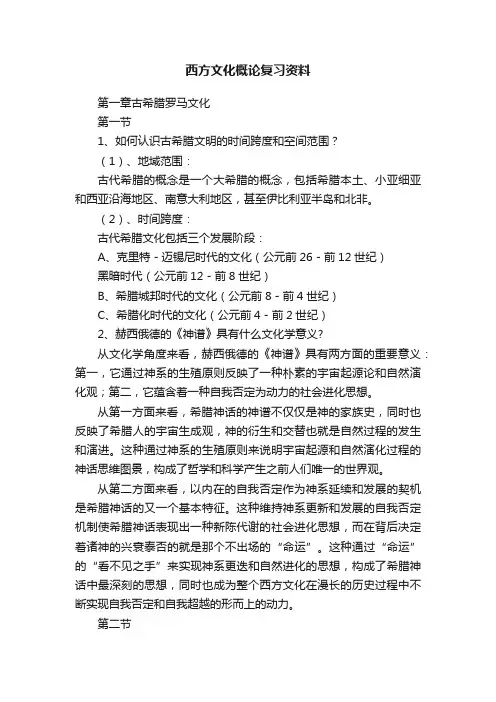
西方文化概论复习资料第一章古希腊罗马文化第一节1、如何认识古希腊文明的时间跨度和空间范围?(1)、地域范围:古代希腊的概念是一个大希腊的概念,包括希腊本土、小亚细亚和西亚沿海地区、南意大利地区,甚至伊比利亚半岛和北非。
(2)、时间跨度:古代希腊文化包括三个发展阶段:A、克里特-迈锡尼时代的文化(公元前26-前12世纪)黑暗时代(公元前12-前8世纪)B、希腊城邦时代的文化(公元前8-前4世纪)C、希腊化时代的文化(公元前4-前2世纪)2、赫西俄德的《神谱》具有什么文化学意义?从文化学角度来看,赫西俄德的《神谱》具有两方面的重要意义:第一,它通过神系的生殖原则反映了一种朴素的宇宙起源论和自然演化观;第二,它蕴含着一种自我否定为动力的社会进化思想。
从第一方面来看,希腊神话的神谱不仅仅是神的家族史,同时也反映了希腊人的宇宙生成观,神的衍生和交替也就是自然过程的发生和演进。
这种通过神系的生殖原则来说明宇宙起源和自然演化过程的神话思维图景,构成了哲学和科学产生之前人们唯一的世界观。
从第二方面来看,以内在的自我否定作为神系延续和发展的契机是希腊神话的又一个基本特征。
这种维持神系更新和发展的自我否定机制使希腊神话表现出一种新陈代谢的社会进化思想,而在背后决定着诸神的兴衰泰否的就是那个不出场的“命运”。
这种通过“命运”的“看不见之手”来实现神系更迭和自然进化的思想,构成了希腊神话中最深刻的思想,同时也成为整个西方文化在漫长的历史过程中不断实现自我否定和自我超越的形而上的动力。
第二节1、希腊神话的“神人同形同性”特点反映了什么样的文化精神?A:神人同形——希腊人的自然崇拜和感觉主义,崇尚完美的形体。
B:神人同性——神与人一样具有七情六欲、喜怒哀乐,像人一样会犯错,经常到人间来滋生是非、拈花惹草。
由此导致了希腊神话和整个希腊文化的和谐之美的基本特点。
在希腊宗教和希腊文化中,自然崇拜和感觉主义构成了最基本的特征。
肉体与精神的原始和谐,使整个希腊文化呈现出一种田园诗般纯净悠扬的意境。
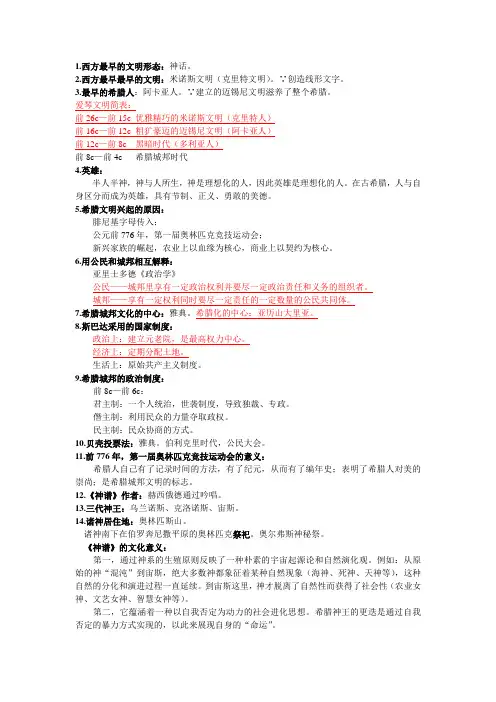
1.西方最早的文明形态:神话。
2.西方最早最早的文明:米诺斯文明(克里特文明)。
∵创造线形文字。
3.最早的希腊人:阿卡亚人。
∵建立的迈锡尼文明滋养了整个希腊。
爱琴文明简表:前26c—前15c 优雅精巧的米诺斯文明(克里特人)前16c—前12c 粗犷豪迈的迈锡尼文明(阿卡亚人)前12c—前8c 黑暗时代(多利亚人)前8c—前4c 希腊城邦时代4.英雄:半人半神,神与人所生,神是理想化的人,因此英雄是理想化的人。
在古希腊,人与自身区分而成为英雄,具有节制、正义、勇敢的美德。
5.希腊文明兴起的原因:腓尼基字母传入;公元前776年,第一届奥林匹克竞技运动会;新兴家族的崛起,农业上以血缘为核心,商业上以契约为核心。
6.用公民和城邦相互解释:亚里士多德《政治学》公民——城邦里享有一定政治权利并要尽一定政治责任和义务的组织者。
城邦——享有一定权利同时要尽一定责任的一定数量的公民共同体。
7.希腊城邦文化的中心:雅典。
希腊化的中心:亚历山大里亚。
8.斯巴达采用的国家制度:政治上:建立元老院,是最高权力中心。
经济上:定期分配土地。
生活上:原始共产主义制度。
9.希腊城邦的政治制度:前8c—前6c:君主制:一个人统治,世袭制度,导致独裁、专政。
僭主制:利用民众的力量夺取政权。
民主制:民众协商的方式。
10.贝壳投票法:雅典。
伯利克里时代,公民大会。
11.前776年,第一届奥林匹克竞技运动会的意义:希腊人自己有了记录时间的方法,有了纪元,从而有了编年史;表明了希腊人对美的崇尚;是希腊城邦文明的标志。
12.《神谱》作者:赫西俄德通过吟唱。
13.三代神王:乌兰诺斯、克洛诺斯、宙斯。
14.诸神居住地:奥林匹斯山。
诸神南下在伯罗奔尼撒平原的奥林匹克祭祀。
奥尔弗斯神秘祭。
《神谱》的文化意义:第一,通过神系的生殖原则反映了一种朴素的宇宙起源论和自然演化观。
例如:从原始的神“混沌”到宙斯,绝大多数神都象征着某种自然现象(海神、死神、天神等),这种自然的分化和演进过程一直延续。
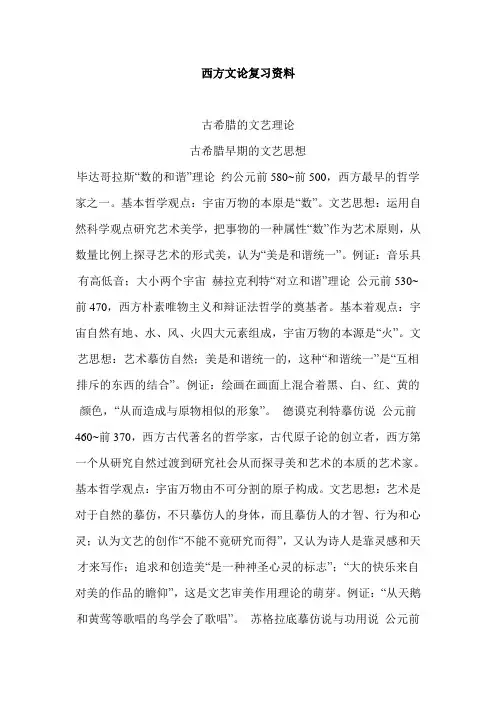
西方文论复习资料古希腊的文艺理论古希腊早期的文艺思想毕达哥拉斯“数的和谐”理论约公元前580~前500,西方最早的哲学家之一。
基本哲学观点:宇宙万物的本原是“数”。
文艺思想:运用自然科学观点研究艺术美学,把事物的一种属性“数”作为艺术原则,从数量比例上探寻艺术的形式美,认为“美是和谐统一”。
例证:音乐具有高低音;大小两个宇宙赫拉克利特“对立和谐”理论公元前530~前470,西方朴素唯物主义和辩证法哲学的奠基者。
基本着观点:宇宙自然有地、水、风、火四大元素组成,宇宙万物的本源是“火”。
文艺思想:艺术摹仿自然;美是和谐统一的,这种“和谐统一”是“互相排斥的东西的结合”。
例证:绘画在画面上混合着黑、白、红、黄的颜色,“从而造成与原物相似的形象”。
德谟克利特摹仿说公元前460~前370,西方古代著名的哲学家,古代原子论的创立者,西方第一个从研究自然过渡到研究社会从而探寻美和艺术的本质的艺术家。
基本哲学观点:宇宙万物由不可分割的原子构成。
文艺思想:艺术是对于自然的摹仿,不只摹仿人的身体,而且摹仿人的才智、行为和心灵;认为文艺的创作“不能不竟研究而得”,又认为诗人是靠灵感和天才来写作;追求和创造美“是一种神圣心灵的标志”;“大的快乐来自对美的作品的瞻仰”,这是文艺审美作用理论的萌芽。
例证:“从天鹅和黄莺等歌唱的鸟学会了歌唱”。
苏格拉底摹仿说与功用说公元前469~前399,西方著名的唯心主义哲学家。
哲学中心思想:神学目的论。
文艺思想:“艺术摹仿自然”的内涵变化:不是摹仿人物的外形,而是强调描绘人物“精神方面的特质”,即描绘人物的心境、神色和感情,从社会角度观察研究文艺;提出如何创造“美的形象”的问题:判断美的标准是“功用”,有用即美,无用即丑;美具有相对性;一个事物的善恶美丑不在于事物本身固有的性质,而在于它和人的关系即是否符合人的功利的目的。
柏拉图的文艺对话录。
理式论摹仿说公元前427~前347。
哲学思想:“理式”(Idea)论是他哲学体系的基石。
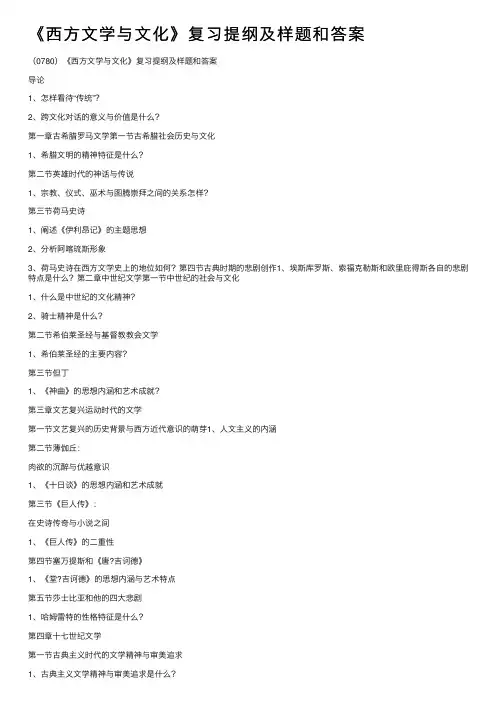
《西⽅⽂学与⽂化》复习提纲及样题和答案(0780)《西⽅⽂学与⽂化》复习提纲及样题和答案导论1、怎样看待“传统”?2、跨⽂化对话的意义与价值是什么?第⼀章古希腊罗马⽂学第⼀节古希腊社会历史与⽂化1、希腊⽂明的精神特征是什么?第⼆节英雄时代的神话与传说1、宗教、仪式、巫术与图腾崇拜之间的关系怎样?第三节荷马史诗1、阐述《伊利昂记》的主题思想2、分析阿喀琉斯形象3、荷马史诗在西⽅⽂学史上的地位如何?第四节古典时期的悲剧创作1、埃斯库罗斯、索福克勒斯和欧⾥庇得斯各⾃的悲剧特点是什么?第⼆章中世纪⽂学第⼀节中世纪的社会与⽂化1、什么是中世纪的⽂化精神?2、骑⼠精神是什么?第⼆节希伯莱圣经与基督教教会⽂学1、希伯莱圣经的主要内容?第三节但丁1、《神曲》的思想内涵和艺术成就?第三章⽂艺复兴运动时代的⽂学第⼀节⽂艺复兴的历史背景与西⽅近代意识的萌芽1、⼈⽂主义的内涵第⼆节薄伽丘:⾁欲的沉醉与优越意识1、《⼗⽇谈》的思想内涵和艺术成就第三节《巨⼈传》:在史诗传奇与⼩说之间1、《巨⼈传》的⼆重性第四节塞万提斯和《唐?吉诃德》1、《堂?吉诃德》的思想内涵与艺术特点第五节莎⼠⽐亚和他的四⼤悲剧1、哈姆雷特的性格特征是什么?第四章⼗七世纪⽂学第⼀节古典主义时代的⽂学精神与审美追求1、古典主义⽂学精神与审美追求是什么?2、何谓“三⼀律”?第⼆节莫⾥哀与他的喜剧1、《伪君⼦》的思想内涵及其艺术成就2、答丢夫的性格特征是什么?第五章⼗⼋世纪启蒙⽂学第⼀节启蒙运动与启蒙⽂学1、启蒙⽂学的主要特征是什么?第⼆节完美结构艺术的杰作:《汤姆·琼斯》1、《汤姆·琼斯》的思想内涵和艺术特⾊是什么?第三节歌德1、何谓“狂飙突进”?2、浮⼠德形象的意义第六章19世纪浪漫主义⽂学第⼀节19世纪初的⽂化与⽂学1、浪漫主义⽂学特点?第⼆节华兹华斯和湖畔派诗⼈1、何谓“湖畔派”“2、华兹华斯诗歌的特点第三节拜伦:超越⾃卑的恶魔诗⼈1、唐璜形象的特点?第四节⾬果与《巴黎圣母院》1、《巴黎圣母院》的思想主题第七章19世纪现实主义⽂学第⼀节19世纪现实主义⽂学发⽣发展概况1、现实主义⽂学的特点第⼆节司汤达:⼼理描写的⼤师1、《红与⿊》的艺术成就第三节巴尔扎克:⾦钱体验的“历史书记员”1、《⼈间喜剧》的整体成就2、《⾼⽼头》的思想主题第四节福楼拜:游移于现实主义与现代主义之间1、《包法利夫⼈》的思想内涵2、福楼拜⼩说的艺术成就3、爱玛形象的特征第五节哈代:英国⽂明的强⼒批判者1、《德伯家的苔丝》的思想内涵与艺术特征第六节陀思妥耶夫斯:复调⼩说的开创者1、拉斯柯尔尼科夫的⼆重性第七节列夫·托尔斯泰:宗法制的古典情怀1、安娜的爱情悲剧的价值与意义(0780)《西⽅⽂学与⽂化》样题及答案⼀、填空题(每空1分,⼤致10分)1、西⽅⽂化的主体精神主要包括与传统。
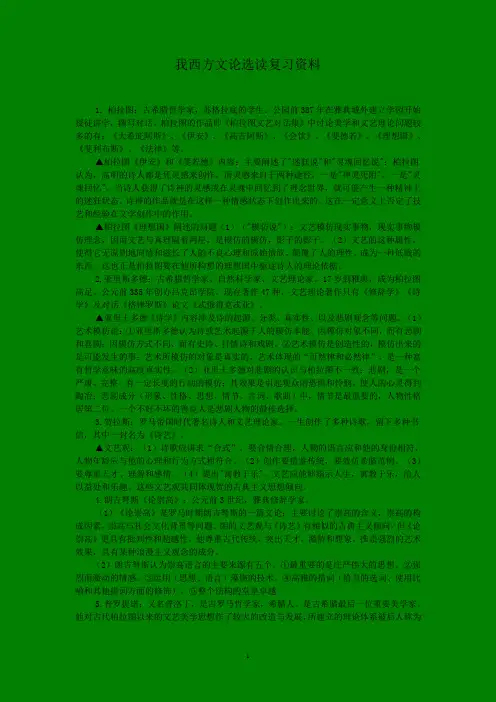
我西方文论选读复习资料1.柏拉图:古希腊哲学家,苏格拉底的学生。
公园前387年在雅典城外建立学园开始授徒讲学,撰写对话。
柏拉图的作品即《柏拉图文艺对话集》中讨论美学和文艺理论问题较多的有:《大希庇阿斯》、《伊安》、《高吉阿斯》、《会饮》、《斐德若》、《理想国》、《斐利布斯》、《法律》等。
▲柏拉图《伊安》和《斐若德》内容:主要阐述了"迷狂说"和"灵魂回忆说":柏拉图认为,高明的诗人都是凭灵感来创作,而灵感来自于两种途径,一是"神灵凭附",一是"灵魂回忆"。
当诗人获得了诗神的灵感或在灵魂中回忆到了理念世界,就可能产生一种精神上的迷狂状态。
诗神的作品就是在这样一种情感状态下创作出来的。
这在一定意义上否定了技艺和经验在文学创作中的作用。
▲柏拉图《理想国》阐述的问题(1)("模仿说"):文艺模仿现实事物,现实事物模仿理念,因而文艺与真理隔着两层,是模仿的模仿,影子的影子。
(2)文艺的这种属性,使得它无原则地同情和滋长了人的不良心理和原始情欲,颠覆了人的理性,成为一种低贱的东西。
这也正是柏拉图要在他所构想的理想国中驱逐诗人的理论依据。
2.亚里斯多德:古希腊哲学家、自然科学家、文艺理论家。
17岁到雅典,成为柏拉图高足。
公元前335年创办吕克昂学院。
现存著作47种,文艺理论著作只有《修辞学》《诗学》及对话《格律罗斯》论文《忒俄得克忒亚》。
▲亚里士多德《诗学》内容涉及诗的起源、分类、真实性、以及悲剧观念等问题。
(1)艺术模仿说:①亚里斯多德认为诗或艺术起源于人的模仿本能。
因模仿对象不同,而有悲剧和喜剧;因模仿方式不同,而有史诗、抒情诗和戏剧。
②艺术模仿是创造性的,模仿出来的是可能发生的事;艺术所模仿的对象是真实的,艺术体现的“可然律和必然律”,是一种富有哲学意味的高度真实性。
(2)亚里士多德对悲剧的认识与柏拉图不一致:悲剧,是一个严肃、完整、有一定长度的行动的模仿;其效果是引起观众的恐惧和怜悯,使人的心灵得到陶冶;悲剧成分(形象、性格、思想、情节、言词、歌曲)中,情节是最重要的,人物性格居第二位。
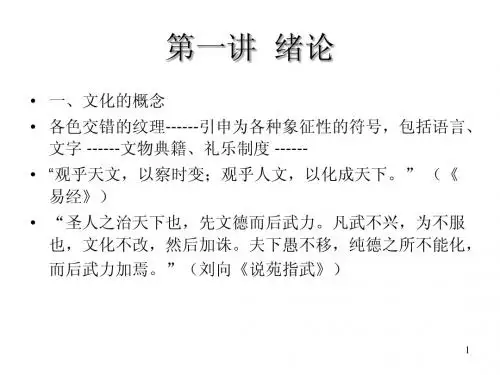
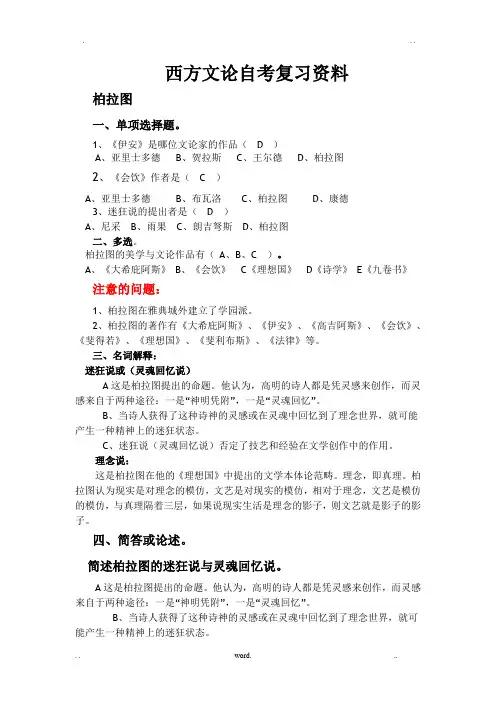
西方文论自考复习资料柏拉图一、单项选择题。
1、《伊安》是哪位文论家的作品(D)A、亚里士多德B、贺拉斯C、王尔德D、柏拉图2、《会饮》作者是( C )A、亚里士多德B、布瓦洛C、柏拉图D、康德3、迷狂说的提出者是( D )A、尼采B、雨果C、朗吉弩斯D、柏拉图二、多选。
柏拉图的美学与文论作品有(A、B、C )。
A、《大希庇阿斯》B、《会饮》C《理想国》D《诗学》E《九卷书》注意的问题:1、柏拉图在雅典城外建立了学园派。
2、柏拉图的著作有《大希庇阿斯》、《伊安》、《高吉阿斯》、《会饮》、《斐得若》、《理想国》、《斐利布斯》、《法律》等。
三、名词解释:迷狂说或(灵魂回忆说)A这是柏拉图提出的命题。
他认为,高明的诗人都是凭灵感来创作,而灵感来自于两种途径:一是“神明凭附”,一是“灵魂回忆”。
B、当诗人获得了这种诗神的灵感或在灵魂中回忆到了理念世界,就可能产生一种精神上的迷狂状态。
C、迷狂说(灵魂回忆说)否定了技艺和经验在文学创作中的作用。
理念说:这是柏拉图在他的《理想国》中提出的文学本体论范畴。
理念,即真理。
柏拉图认为现实是对理念的模仿,文艺是对现实的模仿,相对于理念,文艺是模仿的模仿,与真理隔着三层,如果说现实生活是理念的影子,则文艺就是影子的影子。
四、简答或论述。
简述柏拉图的迷狂说与灵魂回忆说。
A这是柏拉图提出的命题。
他认为,高明的诗人都是凭灵感来创作,而灵感来自于两种途径:一是“神明凭附”,一是“灵魂回忆”。
B、当诗人获得了这种诗神的灵感或在灵魂中回忆到了理念世界,就可能产生一种精神上的迷狂状态。
C、迷狂说(灵魂回忆说)否定了技艺和经验在文学创作中的作用。
亚里士多德一、单项选择题。
1、提出净化说的是(D )A、柏拉图B、康德C、巴尔扎克D、亚里士多德2、亚里士多德对悲剧的认识与柏拉图( B )A、完全一致B、不一致C、相似D、在似与不似之间二、多项选择题。
亚里士多德认为悲剧的六要素是(ABCDE)A、情节B、性格C、言词D、形象E、歌曲注意的问题:悲剧六要素:形象、性格、情节、言词、歌曲与思想。
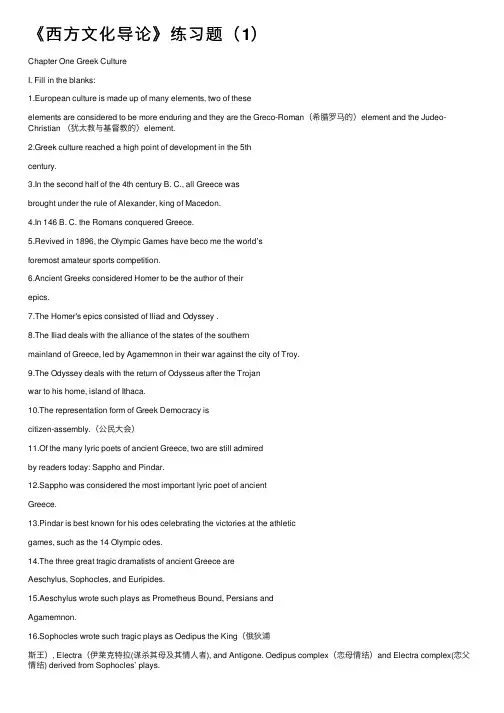
《西⽅⽂化导论》练习题(1)Chapter One Greek CultureI. Fill in the blanks:1.European culture is made up of many elements, two of theseelements are considered to be more enduring and they are the Greco-Roman(希腊罗马的)element and the Judeo-Christian (犹太教与基督教的)element.2.Greek culture reached a high point of development in the 5thcentury.3.In the second half of the 4th century B. C., all Greece wasbrought under the rule of Alexander, king of Macedon.4.In 146 B. C. the Romans conquered Greece.5.Revived in 1896, the Olympic Games have beco me the world’sforemost amateur sports competition.6.Ancient Greeks considered Homer to be the author of theirepics.7.The Homer's epics consisted of Iliad and Odyssey .8.The Iliad deals with the alliance of the states of the southernmainland of Greece, led by Agamemnon in their war against the city of Troy.9.The Odyssey deals with the return of Odysseus after the Trojanwar to his home, island of Ithaca.10.The representation form of Greek Democracy iscitizen-assembly.(公民⼤会)11.Of the many lyric poets of ancient Greece, two are still admiredby readers today: Sappho and Pindar.12.Sappho was considered the most important lyric poet of ancientGreece.13.Pindar is best known for his odes celebrating the victories at the athleticgames, such as the 14 Olympic odes.14.The three great tragic dramatists of ancient Greece areAeschylus, Sophocles, and Euripides.15.Aeschylus wrote such plays as Prometheus Bound, Persians andAgamemnon.16.Sophocles wrote such tragic plays as Oedipus the King(俄狄浦斯王), Electra(伊莱克特拉(谋杀其母及其情⼈者), and Antigone. Oedipus complex(恋母情结)and Electra complex(恋⽗情结) derived from Sophocles’ plays.17.Euripides(欧⾥庇得斯)wrote mainly about women in suchplays as Andromache, Medea, and Trojan Women./doc/2d360294.htmledy also flourished in the 5th century B. C.. Its best writerwas Aristophanes, who has left eleven plays, including Frogs, Clouds, Wasps and Birds.19.Euripides _ is the first writer of "problem plays".20.Herodotus(希罗多德)is often called ―Father of History‖. Hewrote about the wars between Greeks and Persians.21.Thucydides(修西得底斯)described the war between Athensand Sparta and between Athens and Syracuse, a Greek state on the Island of Sicily.22.Pythagoras(毕达哥拉斯)was a bold thinker who had the ideathat all things were numbers.23.Pythagoras was the founder of scientific mathematics.24.Heracleitus(赫拉克利特) believed fire to the primary element ofthe universe, out of which everything else had arisen.25.The greatest names in European philosophy are Socrates, Platoand Aristotle.26.In the 4th century B. C., four schools of philosophers oftenargued with each other, they are the Cynics(⽝儒学派), the Sceptics(怀疑论学派), the Epicureans(伊壁鸠鲁学派), and the Stoics(斯多葛学派).27.Euclid(欧⼏⾥得) is well-known for his Elements《⼏何原本》,a textbook of geometry. 28.To illustrate the principle of the level, Archimedes is said tohave told the king: ―Give me a place to stand, and I will move the world.‖29.Greek architecture can be grouped into three styles: the Doric(多利安式)style which is also called the masculine style; the Ionic(爱奥尼亚式)style which is also called the feminine style;and a later style that is called the Corinthian(科林斯式)style.30.The Acropolis at Athens(雅典卫城)and the Parthenon(万神殿) are the finest monument of Greek architecture and sculpture in more than 2000 years.II. Multiple choices:1.Which culture reached a high point of development in the 5thcentury B. C.?A. Greek CultureB. Roman CultureC. Egyptian CultureD. Chinese Culture2.In _______ the Roman conquered Greece.B.C. B. 700 B. C. C. 146 B.C.D. The 5th century3.Which of the following works described the war led by Agamemnon against the city of Troy?A. Oedipus the KingB. IliadC. OdysseyD. Antigone4.Which of the following is NOT the plays written by Aeschylus?A. AntigoneB. AgamemnonC. PersiansD. Prometheus Bound5.Which of the following is NOT the plays written by Sophocles?A. ElectraB. AntigoneC. Trojan WomanD. Oedipus the King6.Which of the following is the play written by Euripides?A. AntigoneB. PersiansC. ElectraD. Medea7.Which of the following is NOT the greatest tragic dramatist of ancient Greece?A. AristophanesB. EuripidesC. SophoclesD. Aeschylus8.Who ever said that ―You can not step twice into the same river.‖?A. PythagorasB. HeracleitusC. Aristotle9.Who was the founder of scientific mathematics?A. HeracleitusB. AristotleC. SocratesD. Pythagoras10.Who is chiefly noted for his doctrine that ―man is the measure ofall things‖?A. ProtagorasB. PythagorasC. PyrrhonD. EpicurusChapter Two Roman CultureI. Fill in the blanks:1.The burning of Corinth in 146 B. C. marked Roman conquest ofGreece, which was then reduced to a province of the Roman Empire.2.The Roman writer Horace said: ―Captive Greece took her rudeconqueror captive‖.⼤意:征服者反被被征服者所征服。
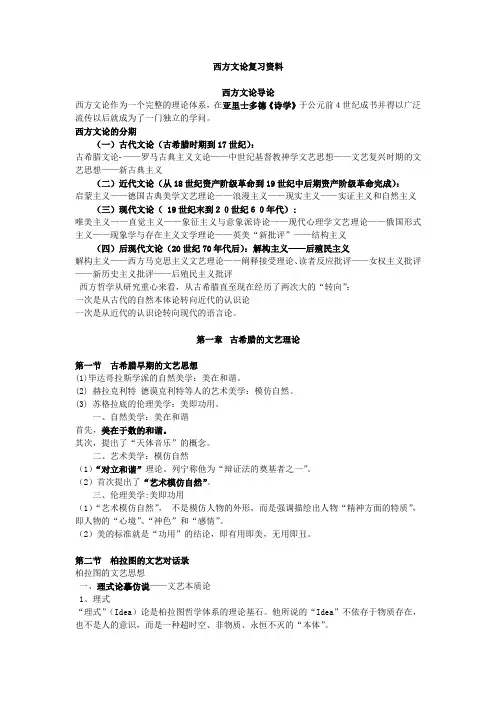
西方文论复习资料西方文论导论西方文论作为一个完整的理论体系,在亚里士多德《诗学》于公元前4世纪成书并得以广泛流传以后就成为了一门独立的学问。
西方文论的分期(一)古代文论(古希腊时期到17世纪):古希腊文论——罗马古典主义文论——中世纪基督教神学文艺思想——文艺复兴时期的文艺思想——新古典主义(二)近代文论(从18世纪资产阶级革命到19世纪中后期资产阶级革命完成):启蒙主义——德国古典美学文艺理论——浪漫主义——现实主义——实证主义和自然主义(三)现代文论( 19世纪末到20世纪60年代):唯美主义——直觉主义——象征主义与意象派诗论——现代心理学文艺理论——俄国形式主义——现象学与存在主义文学理论——英美“新批评”——结构主义(四)后现代文论(20世纪70年代后):解构主义——后殖民主义解构主义——西方马克思主义文艺理论——阐释接受理论、读者反应批评——女权主义批评——新历史主义批评——后殖民主义批评西方哲学从研究重心来看,从古希腊直至现在经历了两次大的“转向”:一次是从古代的自然本体论转向近代的认识论一次是从近代的认识论转向现代的语言论。
第一章古希腊的文艺理论第一节古希腊早期的文艺思想(1)毕达哥拉斯学派的自然美学:美在和谐。
(2) 赫拉克利特德谟克利特等人的艺术美学:模仿自然。
(3) 苏格拉底的伦理美学:美即功用。
一、自然美学:美在和谐首先,美在于数的和谐。
其次,提出了“天体音乐”的概念。
二、艺术美学:模仿自然(1)“对立和谐”理论。
列宁称他为“辩证法的奠基者之一”。
(2)首次提出了“艺术模仿自然”。
三、伦理美学:美即功用(1)“艺术模仿自然”,不是模仿人物的外形,而是强调描绘出人物“精神方面的特质”,即人物的“心境”、“神色”和“感情”。
(2)美的标准就是“功用”的结论,即有用即美,无用即丑。
第二节柏拉图的文艺对话录柏拉图的文艺思想一、理式论摹仿说——文艺本质论1、理式“理式”(Idea)论是柏拉图哲学体系的理论基石。
西方文论复习《西方文论》期末复习资料重点:一、古希腊文化1、毕达哥拉斯的“数的和谐”理论:毕达哥拉斯认为万物从数而产生,数是构成事物的基本单元。
他发现了万物都存在某种数量关系,提出了数和谐的基本思想理论,毕达哥拉斯的数理精神成为理论创新与技术变革的内在动力,极大促进和推动了人类文明和社会进步。
2、赫拉克利特的“对立和谐”理论:赫拉克利特是西方朴素唯物主义和辩证法哲学的奠基者。
他把“火”看作宇宙万物的本源。
整个天体就是地、水、火、风四大元素的运动过程,其运动变化的动力是事物对立面的冲突和斗争。
(1)“对立和谐”理论。
列宁称他为“辩证法的奠基者之一”。
(2)首次提出了“艺术模仿自然”。
3、德谟克利特的“模仿说”德谟克利特是西方古代原子论的创立者。
认为宇宙万物是由不可分割的原子构成4、苏格拉底的模仿说与功用说苏格拉底和他的学生柏拉图及柏拉图的学生亚里士多德被并称为“希腊三贤”。
(1)“艺术模仿自然”,不是摹仿人物的外形,而是强调描绘出人物“精神方面的特质”,即人物的“心境”、“神色”和“感情”。
(2)美的标准就是“功用”的结论,即有用即美,无用即丑。
5、柏拉图文艺思想的基本内容1. 理式论摹仿说。
柏拉图的“理式”是指不依赖于物质存在,也不是人的意识,他认为文学艺术是理式的摹仿的摹仿。
“理式”是第一性的,“自然”是第二性的,柏拉图的理式论摹仿说是唯心主义的,首先,理式论摹仿说从本体论来说是客观唯心主义的,但从认识论来说却是反映论。
其次,理式论摹仿说在对文艺的真实性的否认中,隐约体现了文学艺术的共性方面的要求。
文艺的社会功用说。
柏拉图从他对文学本质的认识——诗是理式的摹仿的摹仿以及培养城邦保卫者建立理想国的政治理想出发,指出摹仿的艺术的三条罪状:a摹仿的艺术与真理隔着三层、诗人没有真知识;b摹仿的艺术以虚构的谎言亵渎神明、贬低英雄;c诗人为了讨好群众,摹仿“人性中低劣的部分”,助长人的“伤感癖”、“哀怜癖”,摧残人的理性,是“城邦保卫者”失去勇敢镇静的精神品质。
西方文论复习资料《西方文论》复资料XXX整理西方文论复资料一、填空(15%)1、美在“数的和谐统一”的思想是由XXX学派提出来的。
2、XXX是西方第一个从研究自然过渡到研究社会、探求美和艺术的本质的哲学家。
3、在XXX的悲剧理论中,居于悲剧六个成分(性格、思想、情节、言词、形象和歌曲)之首的是情节。
4、“灵魂回忆”说是XXX灵感理论的一部分,其意是说灵感的获得过程是灵魂对真善美的理式世界的回忆。
5、《论崇高》这部作品大约完成于公元前一世纪,作者XXX是与XXX同一时代的人。
6、XXX“寓教于乐”理论揭示了文学艺术的审美作用和认识教育作用的关系。
7、“四义说”是XXX提出的关于文学语言的重要理论,它揭示了语言艺术意义的多层次性,这四义分别指的是语言的字面义、譬喻义、道德义和寓言义。
8、17世纪法国新古典主义时期的代表性文论家是的XXX,反映他古典主义实际的主要著作是《诗的艺术》。
9、在XXX对诗与画的界限做分别时认为诗与画有不同的美学原则,画的最高原则是美,诗的最高原则是真。
10、法国启蒙主义文论家中先崇尚XXX后又完全贬低XXX的作家是XXX。
11、在法国古典主义那里,理性即等于自然,等于古典P105。
(不肯定)另一个答案是“道德”12、德国十八世纪卓越的艺术史家XXX提出古希腊艺术的最高理想是“尊贵的纯真”和“静穆的伟大”,此论影响了这一时代许多的诗人、艺术家,包括XXX。
13、XXX的主要美学著作是《审美教育书简》和《朴素的诗和伤感的诗》。
14、作为XXX一切哲学和美学思想的出发点是他的理性万能论。
190(不确定)15、XXX艺术哲学的基本命题是“美是理念的感性显现”。
16、英国文艺复兴时期文论家XXX对诗人给予了极高的评价,他说“世界是铜的,而只有诗人才给予我们金的。
”17、XXX关于悲剧冲突的本质理论认为悲剧冲突起源于“好人犯了错误”。
18、XXX论述文艺的主要著作是《诗学》19、XXX的主要文艺著作是《诗艺》20、XXX的文艺理论著作是《诗的艺术》21、XXX的美学和文艺思想主要在他的《判断力批判》里得到了表述。
西方文化入门复习题填空题1. The earliest civilization in Greece was the Cretan Civilization, also known as the Minoan Civilization.2. At the end of Mycenaean civilization, the Trojan War broke out.3. In the 6th Century B.C. the city of Sparta gained greater control of Peloponnesus by organizing an alliance of almost all the Peloponnesian states.4. The Persian wars, which were between Greek states and Persia, ended with The Battle of Marathon.5. In Greek mythology, the Olympian gods include Zeus, Hestia, Poseidon, Hades, Demeter, Hera, and other six gods.6. One of the features of Greek mythology is that gods resembled humans.7. Plato was Socrates’ student and the author of The Republic.8. The Senate was a political institution started from ancient Rome and still part of the parliaments in some western countries.9. The first Triumvirate of Rome included Caesar, Pompey, and Crassus.10. The capital city of Byzantine Empire was Constantinople.11. The exiled Jews systematically recomposed their legends and manuscripts into the book Talmud.12. The Bible of Judaism is the same as the New Testament of Christianity.13. Christianity became the sole official religion of the Roman Empire in 392 AD under the emperor Theodosius.14. Christianity has broken up into several factions, principally the Roman Catholicism, the Eastern Orthodoxy, and the Protestantism.15. After the destruction of Roman Empire in 476, Europe entered the Middle Ages, which lasted about a thousand years or so and was dominated by Germanic people whom the Romans had called savage.16. In the 7th Century, Muhammad, an Arabian merchant, founded the religion of Islam.17. The most striking feature of Renaissance was doubtless the flourishing of humanism, which was exemplified by the developments in science, religion,philosophy, literature, art, and education.18. The two leaders of religious reformation in 16th century were Martin Luther in Germany and John Calvin in France.19. Renaissance art was represented by three towering figures: da Vinci, Michelangelo, and Raphael.20. The Enlightenment, which is generally agreed to have originated in France, marked the beginning of the modern era and laid a solid foundation for the later process of the Western modernization.21. The most important book of the French philosopher Rousseau was The Social Contract which argued against the idea that monarchs were divinely empowered to legislate and theorized about the best way to establish a political community in the face of the problems of commercial society.简答题1. In what sense do you think Roman culture owed its accomplishments to the benefits obtained from Greek culture?2. How was the Jewish civilization developed after a tortuous history of split and unification?3. What are the main components of Christianity?4. Why the Byzantine Empire could stay much longer than the Western Roman Empire?5. What are the major achievements of the Renaissance?6. Briefly introduce two representative figures of the Enlightenment and their central ideas.。
西方文论选复习精要1. 柏拉图的作品有:《大希庇阿斯》、《伊安》、《高吉阿斯》、《会饮》、《斐德若》、《理想国》、《斐利布斯》、《法律》。
2. 柏拉图的"迷狂说"和"灵魂回忆说":高明的诗人都是凭灵感来创作,而灵感来自于两种途径,一是"神灵凭附",一是"灵魂回忆"。
当诗人获得了诗神的灵感或在灵魂中回忆到了理念世界,就可能产生一种精神上的迷狂状态。
诗神的作品就是在这样一种情感状态下创作出来的。
在一定意义上否定了技艺和经验在文学创作中的作用。
3. 柏拉图的"理念说":文艺模仿现实事物,现实事物模仿理念,因而文艺与真理隔着两层,是模仿的模仿,影子的影子。
4. 亚里士多德对悲剧的认识与柏拉图不一致。
5. 亚里士多德的悲剧:是一个严肃、完整、有一定长度的行动的模仿;其效果是引起观众的恐惧和怜悯,使人的心灵得到陶冶;悲剧成分中,情节是最重要的,人物性格居第二位。
寓教于乐"。
6. 贺拉斯是罗马帝国文艺家。
提出"7. 朗吉弩斯认为崇高语言的主要来源有五个。
8. 《论崇高》是罗马时期朗吉弩斯的一篇文论;主要讨论了崇高的含义,崇高的构成因素,崇高与社会文化背景等问题。
9. 普罗提诺将"太一"视为宇宙和艺术的本源。
10. 奥古斯丁是教父神学文论者。
11. 阿奎拉主张:文艺思想是以神学的本体论为前提的。
12. 锡德尼认为:诗高于其它学术,是学术之父。
13. 达o芬奇扬画抑诗。
14. 卡斯特尔维屈罗是意大利文论家。
15. 布瓦洛对新古典主义的理论原则和理想的概括:崇尚理性;摹仿自然;皈依古典,人物塑造类型化,戏剧创作遵守三一律,诗人要加强人格修养,肩负起教化社会的使命。
16. 《论戏剧诗》主要讨论了狄德罗大力提倡的"严肃剧"的问题。
17. 莱辛认为:诗歌在表现力和整体的优越性上强于绘画。
西方文化概论第一章爱琴文化和希腊神话传说一、米诺斯文明Crete 克里特岛是米诺斯文明的发源地;是西方文化的源头、摇篮、起源之所在。
克诺索斯王宫————————迷宫克里特人使用的文字————线形文字A米诺斯文明史上古文明由西亚、北非向欧洲大陆传播的一个重要阶段,也是古代希腊文化的第一个繁荣时期。
二、迈锡尼文明(1)迈锡尼文明的缔造者为阿卡亚人。
(2)爱琴文明包括米诺斯文明和迈锡尼文明,是古代爱琴海地区青铜文化的统称。
(3)迈锡尼人的文字————线形文字B(4)阿卡亚人对爱琴海地区的血与火的征服活动构成了希腊英雄传说的历史愿望。
《荷马史诗》征服true。
(5)迈锡尼走向衰落的关键因素:迈锡尼攻陷特洛伊。
——————衰落。
三、荷马时代(黑暗时代)N(1)特洛伊战争之后,繁荣的爱琴文明彻底衰落了,希腊由此进入了荷马时代。
所谓的荷马时代是指公元前1100年——前800年这一段时间,正是荷马史诗反应的时代,故被称为荷马时代。
(2)荷马史诗由《伊利亚特》和《奥德赛》两部分构成。
两既彼此独立又相互联系大的部分。
(3)《荷马史诗》并非出自于一人之手,是古希腊全民共同智慧的结晶。
(4)《伊利亚特》的线索:阿卡琉斯的愤怒。
(5)出自于特洛伊战争的成语典故:木马计传说古代希腊人攻打特洛伊城九年不下,后来用一计策,把一批勇士藏在一只特制的木马中,佯装撤退,扔下木马。
特洛伊人把木马当作战利品运进城内。
夜里木马中的勇士出来打开城门,与攻城军队里应外合,占领了特洛伊城。
后称潜入敌方内部进行破坏和颠覆活动的办法为“木马计”。
,阿卡琉斯之踵阿喀琉斯,是凡人泊琉斯和美貌仙女忒提斯的宝贝儿子。
忒提斯为了让儿子炼成“金钟罩”,在他刚出生时就将其倒提着浸进冥河,遗憾的是,乖儿被母亲捏住的脚后跟却不慎露在水外,全身留下了惟一一处“死穴”。
后来,阿喀琉斯被赫克托尔弟弟帕里斯一箭射中了脚踝而死去。
后人常以“阿喀琉斯之踵”譬喻这样一个道理:即使是再强大的英雄,他也有致命的死穴或软肋。
西方文论期末复习资料(推荐5篇)第一篇:西方文论期末复习资料西方文论一、亚里士多德的悲剧理论:1、悲剧定义:悲剧是对一个严肃、完整、有一定长度的行动的模仿,他用的是语言,具有各种精心雕琢的装饰,个就其位地在剧的各个部分,模仿的样式是戏剧表演,不是一味叙述;通过引起怜悯和恐惧之情,而是这两种感情得到净化。
2、悲剧的四因:质料因、形式因、动力因和目的因。
3、悲剧的六个成分:情节、性格、言词、思想、形象和歌曲。
二、贺拉斯:1、生平:屋大维统治下的著名诗人,写讽刺是和抒情诗;2、古典主义三原则:(1)模仿说(借鉴原则):在秉承亚里士多德的文艺模仿人生急促上提出文艺模仿古典(古希腊典范)的原则,主张向前人学习;A、沿用古典题材(讲古希腊诗篇改为戏剧);B、提倡发现新体裁;(2)合式原则:恰如其分的表现诗中描绘的人物,艺术上的协调一致、恰当、得体,符合自然、情理、观众心理和艺术的原则;具体要求:A、结构上虚实参差,毫无破绽;B、人物性格自相一致,合乎类型,合乎特征;(类型说,定型说)C、要有高贵的内容和优雅的形式:要求文艺必须是高贵的、优雅的,要有阶级内含,是雅俗文化划分的滥觞;(3)理性原则:作家素质论:A、认为作家最重要的素质是判断力,即艺术家正确的思辨能力(如何判断改写什么和怎么写的能力);B、技艺训练的三个方面:a、模仿古希腊作品,将其作为范例;b、要敢于创新c、敢于接受批评,不断修改作品;作家正确判断力的源头:思想、道德、知识。
3、寓教于乐说:教:诗的教化功能乐:娱乐(1)认为诗的教化功能和娱乐作用并举(寓教于乐说的核心);(2)认为诗人给人益处(教化功能)和乐趣(娱乐),将乐看作是教的手段,使其为政治、法律服务。
容易走向极端。
三、朗基努斯《论崇高》:1、《论崇高》:西方文学史上最早谈论“风格论”的著作,“风格”是指“崇高的风格”,认认为崇高的作品能给人以惊叹和狂喜,不容判断而必然接受,感染力是不可抗拒的,使读者陷入迷狂状态,文学上的崇高是指伟大心灵的回声。
西方文化导论选择题10道填空题10道概念题4道问答题2道(课后题)一、概念题1.Da VinciLeonardo di ser Piero Da Vinci was an Italian Renaissance polymath: painter, sculptor, architect, musician, scientist, mathematician, engineer, inventor, anatomist, geologist, cartographer, botanist and writer. Leonardo has often been described as the archetype of the Renaissance Man, a man of "unquenchable curiosity" and "feverishly inventive imagination". He is widely considered to be one of the greatest painters of all time and perhaps the most diversely talented person ever to have lived. According to art historian Helen Gardner, the scope and depth of his interests were without precedent and "his mind and personality seem to us superhuman, the man himself mysterious and remote". Marco Rosci points out, however, that while there is much speculation about Leonardo, his vision of the world is essentially logical rather than mysterious, and that the empirical methods he employed wereunusual for his time.2. ShakespeareWilliam Shakespeare was an English poet and playwright, widely regarded as the greatest writer in the English language and the world's pre-eminent dramatist. He is often called England's national poet and the "Bard of Avon". His surviving works, including some collaborations, consist of about 38 plays, 154 sonnets, two long narrative poems, and several other poems. His plays have been translated into every major living language and are performed more often than those of any other playwright.3.black humorThe definition of black humor is problematic; it has been argued that it corresponds to the earlier concept of gallows humor; and that, as humor has been defined since Freud as a comedic act that anesthetizes an emotion, all humor is "black humor," and that there is no such thing as "non-black humor".二、填空题1. Pindar is best known for his odes celebrating the victories at the athletic games, such as the 14 Olympic odes.2. The three great tragic dramatists of ancient Greece are Aeschylus, Sophocles, and Euripides.3. Aeschylus wrote such plays as Prometheus Bound, Persians andAgamemnon.4. Euripides(欧里庇得斯) wrote mainly about women in such plays as Andromache, Medea, and Trojan Women.5. Comedy also flourished in the 5th century B. C.. Its best writer was Aristophanes, who has left eleven plays, including Frogs, Clouds, Wasps and Birds.6. Euripides _ is the first writer of "problem plays".7.Herodotus(希罗多德)is often called “Father of History”. He wrote about the wars between Greeks and Persians.8. Thucydides(修西得底斯) described the war between Athens and Sparta and between Athens and Syracuse, a Greek state on the Island of Sicily.9.Pythagoras(毕达哥拉斯) was a bold thinker who had the idea that all things were numbers.10. Pythagoras was the founder of scientific mathematics.11. She-wolf is the statue which illustrates the legend of creation of Roman.12. The dividing range in the Roman history refers to 27 B.C.13. “I came, I saw, I conquered.” is said by Julius Caesar.14. Jesus went with his disciples to Jerusalem for the Passover, but was betrayed by Judas.15. In 313 the Edict of Milan(米兰敕令)was issued byConstantine I and granted religious freedom to all and made Christianity legal.16. In 392 A.D, Emperor Theodosius made Christianity the official religions of the empire and outlawed all other religions.17.Charlemagne,who temporarily restored order in western and central Europe, was perhaps the most important figure of the medieval period.18. Charlemagne was crowed “Emperor of the Romans” by the Pope in 800.19. The Summa Theologica(《神学大全》) by St. Thomas Aquinas (forms an enormous system and sums up all the knowledge of medieval theology.20. In 18th-century England, two writers must be mentioned as far as the periodical essay is concerned: Addison and Steele.21. Both Addison and Steele contributed to The Tatler and The Spectator, two series of periodical essays.22. In 1492the Moors(摩尔人) that had ruled Spain for four centuries were driven out from their last stronghold.23. In 1492Columbus discovered American and claimed America for Spain.24. The most important contributions to the musical world byBeethoven were in those musical forms associated with the growth of the sonata).25. Swan Lake was composed by Tchaikovsky.三、选择题1. Where did the Renaissance start with the flowering of paintings, sculpture and architecture?A. in Greece and RomeB. in Florence and VeniceC. in Milan and FlorenceD. in Italy and Germany2. When did the Renaissance reach its height with its center moving to Milan, then to Rome, and created High Renaissance?A. in the 11th centuryB. in the 15th century thC. in the 16 centuryD. in the 17th century3. Which of the following works is written by Boccaccio?A. DecameronB. CanzoniersC. DavidD. Moses4. Which of the following High Renaissance artists is the father of the modern mode of painting?A. RaphaelB. TitianC. da VinciD. Michelangelo5. Which of the following High Renaissance artists was best known for his Madonna (Virgin Mary)?A. TitianB. da VinciC. MichelangeloD. Raphael6. Who took up the translation of the Bible into English for the first time?A. Jan HusB. John WyliffC. Martin LutherD. John Calvin9. Who is the author Institutes of the Christian Religion?A. John WycliffB. Jan HusC. John CalvinD. Erasmus10. By which year the Moslems had taken over the last Christian stronghold and won the crusades and ruled all the territory in Palestine that the crusaders had fought to control?A. 1270B. 1254C. 1096D. 129111. Which of the following was crowned “Emperor of the Romans” by the Pope in 800? A. St. Thomas Aquinas B. Charlemagne C. Constantine D. King James12. Who was the ruler of the Anglo-Saxon kingdom of Wessex and contributed greatly to the medieval European culture?A. Charles IB. Constantine IC. Alfred the GreatD. Charles the Great13. Does Song of Roland belong to which country’s epic?A. EnglishB. GermanicC. HebrewD. French14. Who is the author of the Opus Maius(《新工具论》)?A. Roger BaconB. Dante AlighieriC. ChaucerD. St. Thomas Aquinas15. Which of the following is NOT the greatest tragic dramatist of ancient Greece? A. Aristophanes B. Euripides C. Sophocles D. Aeschylus。